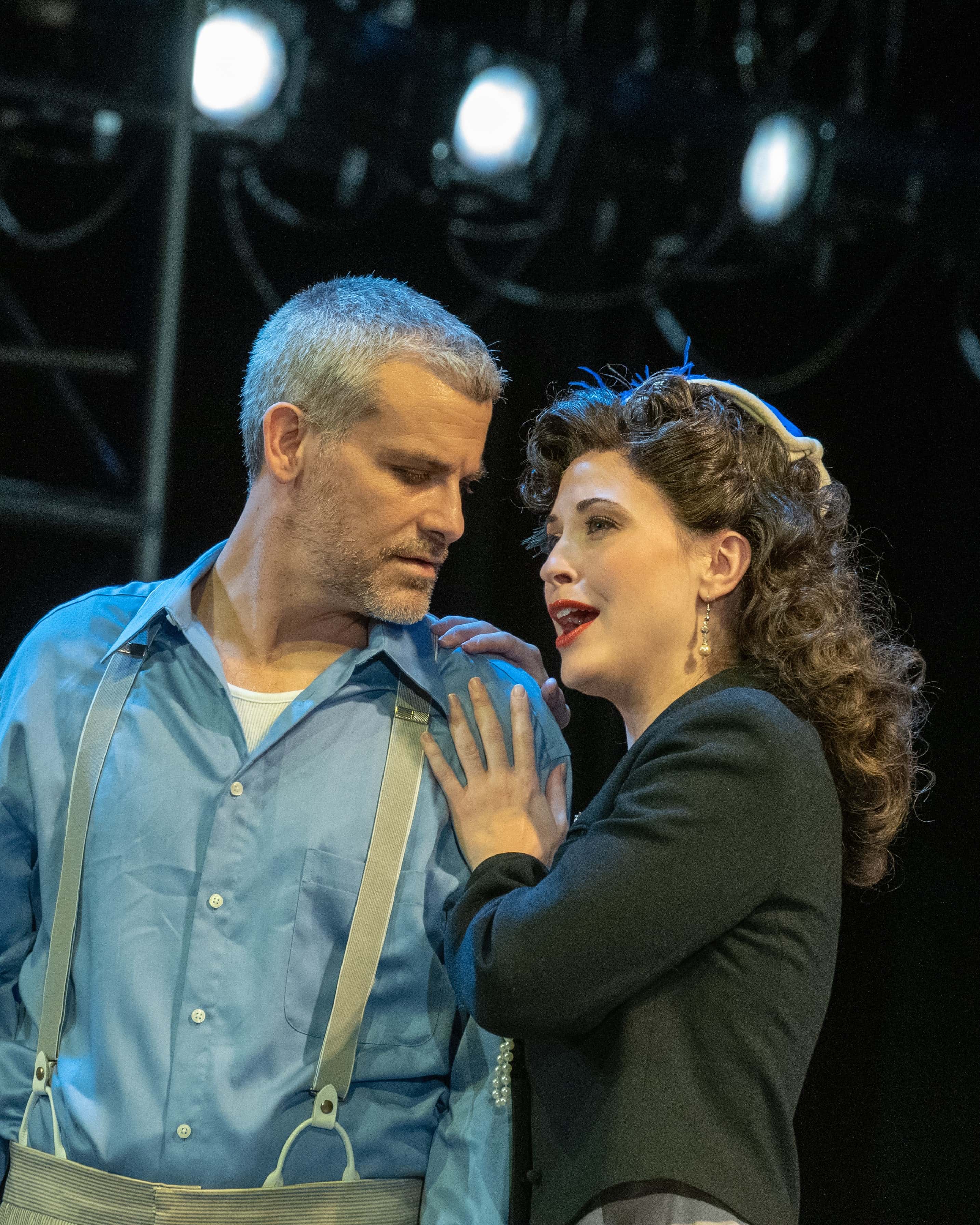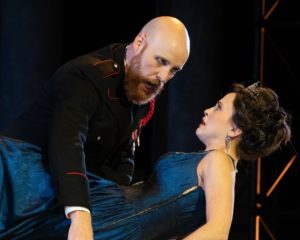Annapolis Opera’s production of Tosca, performed at Maryland Hall for the Creative Arts, is a thrilling work of theater, combining beautiful music, singing, and acting with creative set and lighting design. Guest Director David Lefkowich has set Puccini’s 1900 masterpiece, originally set in 1800, in 1943, as “fascism began to crumble,” according to his program note. With Guest Artistic Director and Conductor Craig Kier leading the Annapolis Symphony Orchestra, it is a powerful way for Annapolis Opera to open their new season.

Shannon Jennings quickly and easily switches powerful emotions as Tosca. In early scenes with her lover Cavaradossi (Derek Taylor), she has a playful air, but with a commanding tone, someone used to having her way. She and Taylor touch each other lovingly throughout. Uncovering the painting, jealousy fills her voice. She has a wonderful physicality, singing “Vissi d’arte” while sitting in the middle of Scarpia’s table, trembling in fear and anguish. In an incredibly powerful moment, she sits on top of Scarpia (Timothy Mix), defiantly turning the tables. She gives her final scene with great drama, her voice full of anguish and pain.
Taylor gives a nobility and strength to the artist Cavaradossi. He is tender and loving towards Jennings, soothing her jealousy. His “Recondita armonia” is lovely, sung with controlled passion. He defiantly stands up to Mix’s questioning, triumphantly singing “Victoria” when good news is heard. He mixes pain and love in “E lucevan le stele,” sobbing as he sings. He passionately embraces Jennings upon seeing her.
Mix plays Baron Scarpia, the police chief, with a relish to his villainy. Everyone in the church trembles when he enters. At the “Te Deum,” he stands in front of the stage, singing triumphantly of his scheme to capture Angelotti (Jarrod Lee) and seduce Jennings. He treats Jennings violently, pulling her close to him, pawing at her, even bending her over his table. He is remarkably calm in his interrogation of Taylor, and in his proposal to Jennings, the threat just under the surface. His end is justly violent, showing Mix’s commitment even after Act II’s end: as soldiers roll him onto a gurney, his death grimace is frozen on his face.
Jarrod Lee plays Angelotti, the escaped political prisoner, with fear. The first to appear onstage, he stumbles into a chair, terrified. Meeting Taylor, he seems a broken man, looking only for freedom. As the Jailer in Act III, he has a quiet nobility. Andrew Adelsberger gives a mixture of piety and comedy as the Sacristan, grumbling at Taylor’s mess and lack of religion. The church bells interrupt him as he is about to eat, forcing him to kneel in prayer. Noticing a dab of paint on his forehead, he grabs a hunk of bread before storming off. Omar Najmi plays Scarpia’s assistant Spoletta with a brutal efficiency. He gleefully tells of chasing down Angelotti, before falling to the floor in terror after revealing he failed to find the fugitive. He silently blocks Jennings from rushing offstage to see Taylor.

Set Designer Timothy Mackabee has constructed a set that serves as an ever-present reminder of Mussolini’s Rome, with a backdrop of columns and brick walls inspired, according to the program notes, by “The Danteum,” “an unrealized monument” combining classical and modernist elements. Above the columns in big, imposing letters, is the phrase “Viva Il Duce.” For Act I, rows of folding chairs are in the middle, on either side of the stage. On the far left is Cavaradossi’s painting, covered by a cloth, with art materials scattered around. For Act II, a long dining table is in the middle, with two candles and chairs on either end. For Act III, straw and sandbags are on the right, along with a stool, while a set of stone steps is in the middle of the backdrop. Cleverly, this production does not use curtains, so the audience can watch the set being assembled during the intermissions.
Costumes by the Washington National Opera, with Costume Coordinator Elizabeth D’Antonio, and Wigs and Make-Up Masters Anne Nesmith and Rachel Kirby, help set the time period. Tosca opens in a long white silk skirt, a black jacket, and blue feathers in her hair, later wearing a blue evening gown, white elbow-length gloves, and a tiara. Cavaradossi wears khaki pants, a blue dress shirt, white suspenders, and a blue stained smock. Angelotti has a gray jacket, blue pants, and a black cap. The Sacristan is in a red robe and skullcap, with a white apron. Scarpia looks fearsome in a black military outfit, carrying a whip, as does Spoletta in his black cape and cap.
Lighting Designer Christopher Brusberg uses great effects for the atmosphere. For Scarpia’s entrance, the lights dramatically turn down low. At the “Te Deum,” they shine, highlighting the performers. For Tosca and Cavaradossi’s duet at the end, the lights shine on them, while during his execution, they shine on him alone.
Guest Conductor Craig Kier leads the Orchestra perfectly, blending the music with the performers’ voices. Guest Director David Lefkowich does a wonderful job. The performers easily navigate the stage and each other, no mean feat for such a large cast. Even those in non-speaking roles help create the right dramatic effect, with lots of carefully choreographed movement from the priests and churchgoers at the end of Act I, to the firing squad in Act III. One note: the gunfire sound is authentic and can be shocking to hear, even though notices about it are throughout the theater. Annapolis Opera’s Tosca thrilled opera lovers and newcomers alike with its dramatic, almost cinematic production of a classic.
Running Time: Approximately 2 hours and 30 minutes, with two 30-minute intermissions.
Tosca plays through November 3, 2019, at Maryland Hall for the Creative Arts, 801 Chase Street, Annapolis, MD. For tickets, call the box office at 410-280-5640 or purchase them online.




